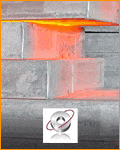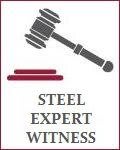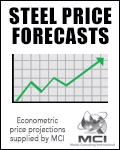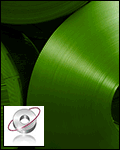DRI Prices.
Steelmaking input costs - Direct Reduced Iron
| Year | Month | Indian exports |
| 2011 | 1 | 412 |
| 2011 | 2 | 428 |
| 2011 | 3 | 465 |
| 2011 | 4 | 454 |
| 2011 | 5 | 462 |
| 2011 | 6 | 464 |
| 2011 | 7 | 470 |
| 2011 | 8 | 478 |
| 2011 | 9 | 487 |
| 2011 | 10 | 625 |
| 2011 | 11 | 678 |
| 2011 | 12 | 442 |
| 2012 | 1 | 453 |
| 2012 | 2 | 531 |
| 2012 | 3 | 494 |
| 2012 | 4 | 476 |
| 2012 | 5 | 467 |
| 2012 | 6 | 466 |
| 2012 | 7 | 449 |
| 2012 | 8 | 428 |
| 2012 | 9 | 377 |
| 2012 | 10 | 392 |
| 2012 | 11 | 607 |
| 2012 | 12 | 409 |
| 2013 | 1 | 408 |
| 2013 | 2 | 418 |
| 2013 | 3 | 431 |
| 2013 | 4 | 407 |
| 2013 | 5 | 409 |
| 2013 | 6 | 369 |
| 2013 | 7 | 371 |
| 2013 | 8 | 389 |
| 2013 | 9 | 323 |
| 2013 | 10 | 341 |
| 2013 | 11 | 346 |
| 2013 | 12 | 369 |
| 2014 | 1 | 365 |
| 2014 | 2 | 353 |
| 2014 | 3 | 341 |
| 2014 | 4 | 381 |
| 2014 | 5 | 359 |
| 2014 | 6 | 376 |
| 2014 | 7 | 376 |
| 2014 | 8 | 372 |
| 2014 | 9 | 376 |
| 2014 | 10 | 384 |
| 2014 | 11 | 363 |
| 2014 | 12 | 339 |
| 2015 | 1 | 355 |
| 2015 | 2 | 340 |
| 2015 | 3 | 327 |
| 2015 | 4 | 304 |
| 2015 | 5 | 308 |
| 2015 | 6 | 297 |
| 2015 | 7 | 268 |
| 2015 | 8 | 261 |
| 2015 | 9 | 251 |
| 2015 | 10 | 252 |
| 2015 | 11 | 233 |
| 2015 | 12 | 211 |
| 2016 | 1 | 204 |
| 2016 | 2 | 202 |
| 2016 | 3 | 211 |
| 2016 | 4 | 217 |
| 2016 | 5 | 217 |
| 2016 | 6 | 211 |
| 2016 | 7 | 217 |
| 2016 | 8 | 209 |
| 2016 | 9 | 207 |
| 2016 | 10 | 216 |
| 2016 | 11 | 227 |
| 2016 | 12 | 240 |
| 2017 | 1 | 243 |
| 2017 | 2 | 242 |
| 2017 | 3 | 255 |
| 2017 | 4 | 261 |
| 2017 | 5 | 282 |
| 2017 | 6 | 285 |
| 2017 | 7 | 259 |
| 2017 | 8 | 261 |
| 2017 | 9 | 278 |
| 2017 | 10 | 287 |
| 2017 | 11 | 281 |
| 2017 | 12 | 269 |
| 2018 | 1 | 276 |
| 2018 | 2 | 332 |
| 2018 | 3 | 358 |
| 2018 | 4 | 351 |
| 2018 | 5 | 338 |
| 2018 | 6 | 338 |
| 2018 | 7 | 330 |
| 2018 | 8 | 313 |
| 2018 | 9 | 316 |
| 2018 | 10 | 334 |
| 2018 | 11 | 344 |
| 2018 | 12 | 330 |
| 2019 | 1 | 313 |
| 2019 | 2 | 307 |
| 2019 | 3 | 304 |
| 2019 | 4 | 296 |
| 2019 | 5 | 298 |
| 2019 | 6 | 297 |
| 2019 | 7 | 281 |
| 2019 | 8 | 312 |
| 2019 | 9 | 246 |
| 2019 | 10 | 243 |
| 2019 | 11 | 240 |
| 2019 | 12 | 242 |
| 2020 | 1 | 254 |
| 2020 | 2 | 275 |
| 2020 | 3 | 266 |
| 2020 | 4 | 256 |
| 2020 | 5 | 245 |
| 2020 | 6 | 254 |
| 2020 | 7 | 230 |
| 2020 | 8 | 236 |
| 2020 | 9 | 257 |
| 2020 | 10 | 264 |
| 2020 | 11 | 278 |
| 2020 | 12 | 326 |
| 2021 | 1 | 356 |
| 2021 | 2 | 352 |
| 2021 | 3 | 350 |
| 2021 | 4 | 377 |
| 2021 | 5 | 398 |
| 2021 | 6 | 407 |
| 2021 | 7 | 417 |
| 2021 | 8 | 425 |
| 2021 | 9 | 415 |
| 2021 | 10 | 435 |
| 2021 | 11 | 449 |
| 2021 | 12 | 430 |
| 2022 | 1 | 417 |
| 2022 | 2 | 454 |
| 2022 | 3 | 470 |
| 2022 | 4 | 510 |
| 2022 | 5 | 485 |
| 2022 | 6 | 442 |
| 2022 | 7 | 415 |
| 2022 | 8 | 432 |
| 2022 | 9 | 431 |
| 2022 | 10 | 436 |
| 2022 | 11 | 408 |
| 2022 | 12 | 394 |
| 2023 | 1 | 396 |
| 2023 | 2 | 409 |
| 2023 | 3 | 413 |
| 2023 | 4 | 401 |
| 2023 | 5 | 392 |
| 2023 | 6 | 366 |
| 2023 | 7 | 361 |
| 2023 | 8 | 346 |
| 2023 | 9 | 368 |
| 2023 | 10 | 375 |
| 2023 | 11 | 368 |
| 2023 | 12 | 346 |
| 2024 | 1 | 337 |
| 2024 | 2 | 336 |
| 2024 | 3 | 324 |
| 2024 | 4 | 330 |
| 2024 | 5 | 352 |
| 2024 | 6 | 356 |
Table last updated: 24th October 2024. Next update: ~ 28th December 2024.
1) Figures above are average monthly fob export [not spot prices] for direct reduced iron shipped from India. All prices are expressed in US dollars per metric tonne.
2) The price data is for harmonised system code #720310 which is defined as ferrous products obtained by direct reduction of iron ore.
3) Note that latest price points (the last one or two months in particular) may change, as additional customs data becomes available.
Direct reduced iron (DRI), also called sponge iron, is produced from the direct reduction of iron ore (in the form of lumps, pellets, or fines) to iron by a reducing gas or carbon produced from natural gas or coal. Its main use is as raw material feedstock for electric furnaces in mini mills, where DRI can be used as a scrap substitute.
Hot briquetted iron (or HBI) is direct reduced iron that has been briquetted under very high pressure and at an elevated temperature to form dense briquettes that are much less porous than DRI and therefore much less reactive to the atmosphere. Oxidisation of DRI generates heat, which in bulk cargoes of DRI can be significant and represent a real hazard. Oxidation of DRI is furthermore is accelerated in the presence of moisture and is substantially increased if the water contains dissolved chlorides, as is the case with seawater. Sea transport of DRI in the form of HBI is thus often preferred, because of safety considerations.
Because direct-reduced iron has about the same iron content as pig iron (typically 90–94%) it is an excellent feedstock for the electric arc furnace. It can also be used in the blast furnace with benefits such as reduced coke rates and higher blast furnace productivity.
To contact us about this DRI prices page please email info@steelonthenet.com.




















